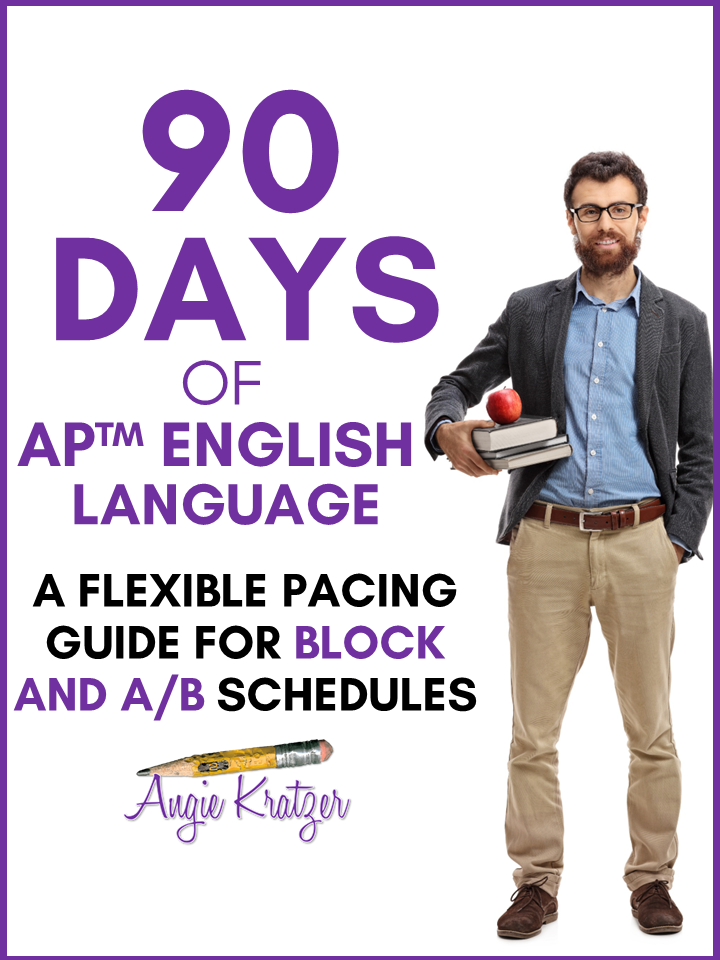
Change is scary. It means new lesson plans and a shift in thinking. For a new AP Lang teacher who JUST GOT her feet under her, it’s maddening. In this case, that change is good for students.
Beginning in 2020, the AP English Language & Composition Exam will be significantly different. Here are the basics and what they mean for us:
- The three free-response questions will use new analytic rubrics. College Board has always used holistic rubrics, which take into account content, organization, style, and conventions in a broad score. Holistic scoring lends itself well to speed and the reward mindset (i.e., giving credit for what the student does well instead of punishing him or her for errors). The problem is that a holistic rubric affords little feedback for either the student or the teacher. For example, if a student scores a 4 on Question 1, that’s all we know. We don’t know how the student earned the score. An analytic rubric gets into the nitty gritty of what goes into a score, so we get more information for improvement and planning. On the classroom level, an analytic rubric slows down grading, but it provides a lot more information to the student about ways to improve writing. Here are some free student-friendly matrix versions of those rubrics.
- The exam will include multiple-choice questions that assess composition. Students will be asked to make revisions to “stimulus texts.” For example, a student might be asked where a specific detail should go in a paragraph. These questions may be similar to the SAT Writing and Language test. Here are some stems from the new Course and Exam Description: ~Which of the following sentences, if place before sentence 1, would both capture the audience’s interest and provide the most effective introduction to the topic of the paragraph? ~The writer wants to add a phrase at the beginning of sentence 5 (reproduced below), adjusting the capitalization as needed, to set up a comparison with the idea discussed in sentence 4. Which of the following choices best accomplishes this goal?
- A few types of multiple-choice questions (e.g., vocabulary in context and identification) will no longer appear on the exam. College Board has phased out esoteric device questions, “Roman Numeral” questions, and EXCEPT questions (thankfully–these were unfair time killers) and will now go even further by removing vocabulary-in-context and identification questions. I’m not sure about the reasoning for the former; context questions can get to the heart of a student’s inference skills. On the latter, my guess is that the ability to identify any device is a test of content, not skill, and that’s not what AP Lang is about. UPDATE: In the new CED, there are two EXCEPT questions in the multiple choice examples. I believe this is bad question design and am trying to get to the bottom of the decision to leave this format as is. More later.
- There will be a consistent range of difficulty in the reading passages across all versions of the exam from year to year. Right now, multiple versions of the AP Lang exam are given each year. According to an article on AP Central, “alternate exam versions are administered to small groups of students in the United States on the regularly scheduled testing date. This means that some or all students in one school may take a different version of the exam than the most commonly administered version. Overall, in a given year, only a small subset of schools in the U.S. receive and administer more than one version of the exam on the regularly scheduled testing date.” Teachers (and students) have access to the free-response questions administered to the majority of students, and some years we can access Form B. In a FAQ section on collegeboard.org, I ran across this question and its answer:
If my AP class is one of the classes for which two versions of the exam are administered this year, how can the College Board guarantee that one version is not easier?Through the process of equating. Because no two versions of a test can be developed to statistically equivalent levels of difficulty, equating is an essential process in the scoring of standardized tests for which score comparability is an important concern.For exams in which two or more versions are administered, an Equivalent Groups Equating Design is applied following a random distribution of the different exam versions to statistically equivalent groups of examinees. The statistical procedures used in the equating process adjust for differences in difficulty among exam versions that are built to be similar in difficulty and content. As a result, the scores from the different versions can be used interchangeably. This allows the AP Program to ensure that students’ scores are unaffected by which version of an exam the students took.I don’t have any insider information here, so take this opinion with a grain of salt. The key word to this change may be range. While there have been tools in place to make sure the versions are of equal difficulty as a whole, the reading difficulty of the individual passages may have been unequal. For example, one exam may have one “easy” contemporary essay, one “challenging” 19th century letter, and three “manageable” mid-difficulty speeches. (I’m totally making this up by the way—it’s just a hypothetical example.) Another version of the exam may have five mid-difficulty pieces. While the difficulty levels may come out in the wash, the ranges are different. That issue will be corrected on the 2020 exam. - There will be fewer questions on the multiple choice section. Through the 2019 exam, this section had 52-55 questions, but the number will drop to 45 questions in 2020. Of all the changes, I’m most excited about this one. I have always struggled with the idea that we want to assess their reading and analysis skills, not the way they manage their time or the speed with which they read. Well done, College Board.
- The passages on the multiple choice section will be shorter. Kudos on this one too! Are we testing skills or stamina?
The new CED includes more resources and guidance for teachers, something we’ve been requesting since the inception of this course. My course may look very different from that of another teacher, but we should both be delivering the same content and building the same skills. The new guidance from College Board may just make that possible.



